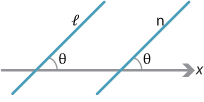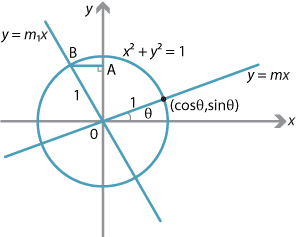Content
Parallel, intersecting and perpendicular lines
The axioms for Euclidean geometry include: Two lines meet at a point or are parallel.

Amongst those pairs of lines which meet, some are perpendicular.

If lines \(l\) and \(n\) are not vertical, then they are parallel if and only if they have the same gradient \(m=\tan\theta\).

Clearly, two horizontal lines are parallel. Also, any two vertical lines are parallel.
If lines \(l\) and \(n\) are not parallel, then their point of intersection can be found by solving the equations of the two lines simultaneously.
Example
Determine whether the following pairs of lines are parallel or identical and, if they are not, find the (unique) point of intersection:
- \(\begin{aligned}[t] y &= x+3\\ y &= x+6 \end{aligned}\)
- \(\begin{aligned}[t] y &= x+3\\ 3y &= 3x+7 \end{aligned}\)
- \(\begin{aligned}[t] y &= x+3\\ 5y &= 5x+15 \end{aligned}\)
- \(\begin{aligned}[t] y &= x+3\\ 2y &= x-2. \end{aligned}\)
Solution
- Both lines have gradient \(m=1\), but they have different \(y\)-intercepts. So the two lines are parallel.
- The lines \(y=x+3\) and \(y=x+\dfrac{7}{3}\) have the same gradient and are therefore parallel.
- The line \(5y=5x+15\) can also be written as \(y=x+3\). So the two lines are the same.
- Number the equations: \begin{alignat*}{2} y &= x+3 &\qquad&(1)\\ 2y &= x-2. &&(2) \end{alignat*} Substituting (1) into (2) gives \(2(x+3)=x-2\), so \(2x+6=x-2\). Therefore \(x=-8\) and \(y=-5\), and the point of intersection is \((-8,-5)\).
Exercise 6
- Find the equation of the line parallel to the \(x\)-axis which passes through the point where the lines \(4x+3y-6=0\) and \(x-2y-7=0\) meet.
- Find the gradient of the line which passes through the point \((2,3)\) and the point of intersection of the lines \(3x+2y=2\) and \(4x+3y=7\).
Perpendicular lines
All vertical lines \(x=a\) are perpendicular to all horizontal lines \(y=b\). So, in the following, we discuss lines with equations \(y=mx+b\), where \(m\ne0\).
Theorem
The lines \(y=mx+b\) and \(y=m_1x+c\) are perpendicular if and only if \(mm_1=-1\).
Proof
It is sufficient to prove that \(y=mx\) is perpendicular to \(y=m_1x\) if and only if \(mm_1=-1\).
Suppose \(y=mx\) meets the \(x\)-axis at angle \(\theta\), that is, \(m=\tan\theta\). For convenience, assume that \(m>0\). Then \(y=mx\) meets the unit circle at \((\cos\theta,\sin\theta)\) in the first quadrant. If \(y=m_1x\) is perpendicular to \(y=mx\), then \(\angle AOB=\theta\), \(AB=\sin\theta\), \(OA=\cos\theta\) and \(B\) is \((-\sin\theta,\cos\theta)\). So
\[ m_1 = \dfrac{\cos\theta}{-\sin\theta} = -\dfrac{1}{\tan\theta} = -\dfrac{1}{m}, \]as required.
Conversely, suppose \(mm_1=-1\) and \(m=\tan\theta\). Then
\[ m_1 = -\dfrac{1}{\tan\theta} = -\dfrac{\cos\theta}{\sin\theta} = \dfrac{\sin \bigl(\dfrac{\pi}{2}+ \theta\bigr)}{\cos\bigl(\dfrac{\pi}{2}+\theta \bigr)} = \tan\Bigl(\dfrac{\pi}{2}+\theta\Bigr). \]Hence \(y=mx\) is perpendicular to \(y=m_1x\).
\(\Box\)
This result is often stated as:
The line \(y=m_1x+c_1\) is perpendicular to the line \(y=m_2x+c_2\) if and only if \(m_1m_2=-1\).
Exercise 7
Use the angle sum formulas
\begin{align*} \sin(A+B) &= \sin A\,\cos B+\cos A\,\sin B\\ \cos(A+B) &= \cos A\,\cos B-\sin A\,\sin B \end{align*} to show that \[ \tan(90^\circ+\theta) = -\dfrac{1}{\tan\theta}. \]Then use this identity to give an alternative proof that lines \(y=mx\) and \(y=m_1x\) are perpendicular if and only if \(mm_1=-1\).
Example
Find the equation of the line \(l\) through \((1,3)\) perpendicular to the line \(2x+3y=12\). Find the equation of the line through \((4,5)\) parallel to \(l\).
Solution
The gradient of the line \(2x+3y=12\) is \(-\dfrac{2}{3}\), so \(l\) has gradient \(\dfrac{3}{2}\). The equation of \(l\) is
\begin{align*} y-3 &= \dfrac{3}{2}(x-1)\\ 2y-6 &= 3x-3\\ 3x-2y+3 &= 0. \end{align*}The other line has equation \(y-5=\dfrac{3}{2}(x-4)\) or, equivalently, \(3x-2y-2=0\).
Example
For each pair of lines, determine whether they are parallel, identical or meet. If they meet, find the point of intersection and whether they are perpendicular.
- \(l:\ 3x=2y+5,\quad n:\ 2x+3y=7\)
- \(l:\ 6x=5y+7,\quad n:\ 12x=10y+13\)
- \(l:\ 3y=2x-1,\quad n:\ 4x=5y-7\)
- \(l:\ 5y=2x+2,\quad n:\ 15y-6x-6=0\)
Solution
- The gradient of \(l\) is \(\dfrac{3}{2}\) and the gradient of \(n\) is \(-\dfrac{2}{3}\). Since
\[
\dfrac{3}{2}\times -\dfrac{2}{3} = -1,
\]
the lines are perpendicular.
We have \begin{alignat*}{2} 6x &= 4y+10 &\qquad&\text{from \(l\),}\\ 6x+9y &= 21 &&\text{from \(n\).} \end{alignat*} Substituting, we obtain \(13y+10=21\) and so \[ y=\dfrac{11}{13}, \qquad x=\dfrac{29}{13}. \] The point of intersection is \(\Bigl(\dfrac{29}{13},\dfrac{11}{13}\Bigr)\). - The lines \(l\) and \(n\) have the same gradient \(\dfrac{6}{5}\). The line \(l\) has \(x\)-intercept \(\dfrac{7}{6}\), and the line \(n\) has \(x\)-intercept \(\dfrac{13}{12}\). So \(l\) is parallel to \(n\), but \(l\ne n\).
- The gradient of \(l\) is \(\dfrac{2}{3}\) and the gradient of \(n\) is \(\dfrac{4}{5}\). So \(l\) meets \(n\), but \(l\) is not perpendicular to \(n\).
We have
\begin{alignat*}{2} 15y &= 10x-5 &\qquad&\text{from \(l\),}\\ 12x &= 15y-21 &&\text{from \(n\).} \end{alignat*} Substituting, we obtain \(12x=10x-5-21\). So \(x=-13\) and \(y=-9\). The point of intersection is \((-13,-9)\). - Rearranging \(15y-6x-6=0\) gives \(5y=2x+2\). So \(l\) and \(n\) are the same line.
Exercise 8
Consider the line \(l\) with equation \(ax+by+c=0\) and the point \(P(x_1,y_1)\).
- Show that the line through \(P\) parallel to \(l\) is given by \(ax+by=ax_1+by_1\).
- Show that the line through \(P\) perpendicular to \(l\) is given by \(bx-ay=bx_1-ay_1\).

